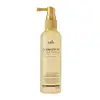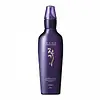What's inside
What's inside
 Key Ingredients
Key Ingredients

 Benefits
Benefits

 Concerns
Concerns

 Ingredients Side-by-side
Ingredients Side-by-side

Water
Skin ConditioningAlcohol Denat.
AntimicrobialPolysorbate 20
EmulsifyingPEG-60 Hydrogenated Castor Oil
EmulsifyingSodium Citrate
BufferingMenthol
MaskingSalicylic Acid
MaskingPanthenol
Skin ConditioningAllantoin
Skin ConditioningNiacinamide
SmoothingHydrolyzed Keratin
HumectantHydrolyzed Collagen
EmollientPropylene Glycol
HumectantHydrolyzed Silk
HumectantPanax Ginseng Root Extract
EmollientHydrolyzed Pepper Fruit Extract
Skin ProtectingLycium Barbarum Fruit Extract
AstringentCamellia Sinensis Leaf Extract
AntimicrobialSmilax China Root Extract
AntimicrobialOak Root Extract
Skin ConditioningXanthium Strumarium Fruit Extract
Skin ConditioningMorus Alba Extract
AstringentPinus Pinaster Leaf Extract
Skin ConditioningBorago Officinalis Extract
EmollientDipotassium Glycyrrhizate
HumectantDisodium EDTA
Butylene Glycol
HumectantPentylene Glycol
Skin Conditioning1,2-Hexanediol
Skin ConditioningCaprylyl Glycol
EmollientPhenoxyethanol
PreservativeParfum
MaskingWater, Alcohol Denat., Polysorbate 20, PEG-60 Hydrogenated Castor Oil, Sodium Citrate, Menthol, Salicylic Acid, Panthenol, Allantoin, Niacinamide, Hydrolyzed Keratin, Hydrolyzed Collagen, Propylene Glycol, Hydrolyzed Silk, Panax Ginseng Root Extract, Hydrolyzed Pepper Fruit Extract, Lycium Barbarum Fruit Extract, Camellia Sinensis Leaf Extract, Smilax China Root Extract, Oak Root Extract, Xanthium Strumarium Fruit Extract, Morus Alba Extract, Pinus Pinaster Leaf Extract, Borago Officinalis Extract, Dipotassium Glycyrrhizate, Disodium EDTA, Butylene Glycol, Pentylene Glycol, 1,2-Hexanediol, Caprylyl Glycol, Phenoxyethanol, Parfum
Water
Skin ConditioningAlcohol
AntimicrobialButylene Glycol
HumectantCnidium Officinale Root Extract
Skin ConditioningArtemisia Princeps Leaf Extract
Skin ConditioningCamellia Sinensis Leaf Extract
AntimicrobialAngelica Acutiloba Root Extract
Skin ConditioningPEG-60 Hydrogenated Castor Oil
EmulsifyingPropylene Glycol
HumectantMenthol
MaskingSalicylic Acid
MaskingPanthenol
Skin ConditioningXanthan Gum
EmulsifyingTriethanolamine
BufferingAllantoin
Skin ConditioningDisodium EDTA
Glycyrrhiza Glabra Root Extract
BleachingPolygonum Multiflorum Root Extract
Skin ConditioningAcorus Calamus Root Extract
PerfumingCapsicum Annuum Fruit Extract
AntimicrobialDipropylene Glycol
HumectantPanax Ginseng Root Extract
Emollient1,2-Hexanediol
Skin ConditioningPhenoxyethanol
PreservativeWater, Alcohol, Butylene Glycol, Cnidium Officinale Root Extract, Artemisia Princeps Leaf Extract, Camellia Sinensis Leaf Extract, Angelica Acutiloba Root Extract, PEG-60 Hydrogenated Castor Oil, Propylene Glycol, Menthol, Salicylic Acid, Panthenol, Xanthan Gum, Triethanolamine, Allantoin, Disodium EDTA, Glycyrrhiza Glabra Root Extract, Polygonum Multiflorum Root Extract, Acorus Calamus Root Extract, Capsicum Annuum Fruit Extract, Dipropylene Glycol, Panax Ginseng Root Extract, 1,2-Hexanediol, Phenoxyethanol
Ingredients Explained
These ingredients are found in both products.
Ingredients higher up in an ingredient list are typically present in a larger amount.
1,2-Hexanediol is a synthetic liquid and another multi-functional powerhouse.
It is a:
- Humectant, drawing moisture into the skin
- Emollient, helping to soften skin
- Solvent, dispersing and stabilizing formulas
- Preservative booster, enhancing the antimicrobial activity of other preservatives
Allantoin is a soothing ingredient known for its protective and moisturizingg properties. Because of this, it is often added to products with strong active ingredients.
Studies show higher concentrations of this ingredient can promote wound healing.
Though it can be derived from the comfrey plant, allantoin is produced synthetically for cosmetic products to ensure purity.
Learn more about AllantoinButylene Glycol (or BG) is used within cosmetic products for a few different reasons:
Overall, Butylene Glycol is a safe and well-rounded ingredient that works well with other ingredients.
Though this ingredient works well with most skin types, some people with sensitive skin may experience a reaction such as allergic rashes, closed comedones, or itchiness.
Learn more about Butylene GlycolCamellia Sinensis Leaf Extract is derived from the leaves of the tea plant. Black tea, green tea, and oolong tea are all harvested from this plant.
This ingredient has many skin benefits:
This ingredient contains polyphenols, a strong antioxidant. Antioxidants help fight off molecules that damage skin cells.
On top of that, the antioxidants in green tea neutralize free-radicals from the sun. This gives the skin some extra UV protection, but should not replace sunscreen.
Many components of tea have anti-inflammatory properties.
Polyphenols and L-theanine help soothe the skin and reduce irritation. The caffeine in Camellia Sinensis Leaf Extract helps calm inflamed blood vessels.
Other compounds found in tea include: Vitamin Bs, linoleic acid, magnesium, calcium, iron, and zinc.
Research has shown both drinking Camellia Sinensis Leaf Tea and applying it to the skin can help boost skin elasticity and hydration. Studies also show using tea extract may reduce sebum, or oil, production.
Learn more about Camellia Sinensis Leaf ExtractDisodium EDTA plays a role in making products more stable by aiding other preservatives.
It is a chelating agent, meaning it neutralizes metal ions that may be found in a product.
Disodium EDTA is a salt of edetic acid and is found to be safe in cosmetic ingredients.
Learn more about Disodium EDTAMenthol is a compound found in mint plants, such as peppermint. In its pure form, it is a clear crystalline substance.
Menthol is known for its cooling sensation; however, the cooling is actually from your skin being sensitized. Menthol can worsen rosacea. We recommend speaking with a professional if you have concerns.
Menthol also has antimicrobial properties.
Learn more about MentholGinseng root is a well-loved ingredient in Asian skincare for good reason. It hydrates the skin, soothes irritation, and helps even out skin tone.
In traditional East Asian medicine, ginseng has been used for centuries both as food and as a healing remedy, and modern research continues to confirm its skin benefits.
One of the standout features of ginseng is its ability to improve blood circulation and oxygen delivery to the skin, bringing a fresh supply of nutrients to support overall skin health. It also has antioxidant and anti-inflammatory properties. This helps to protect your skin against damage from UV exposure, pollution, and daily stress.
Additionally, studies suggest that ginseng may help reduce hyperpigmentation by inhibiting tyrosinase, the enzyme involved in melanin production.
There are different types of ginseng used in skincare, and while they all share core benefits, their potency can vary.
Most products use fresh or white ginseng because it’s more affordable. However, red ginseng, produced by steaming the root, contains higher levels of ginsenosides, which are compounds with proven anti-aging effects. These ginsenosides help reduce the appearance of wrinkles and improve skin elasticity.
Note: All forms of ginseng are listed simply as “Panax ginseng” in ingredient lists. We recommend reaching out to the brand if you have questions about which type of ginseng is used in their ingredients.
For general antioxidant benefits, any ginseng extract will do, but for wrinkle care or firmer skin, red or fermented ginseng is often more effective.
In short, ginseng is a powerhouse ingredient that supports hydration, radiance, and resilience.
Learn more about Panax Ginseng Root ExtractPanthenol is a common ingredient that helps hydrate and soothe the skin. It is found naturally in our skin and hair.
There are two forms of panthenol: D and L.
D-panthenol is also known as dexpanthenol. Most cosmetics use dexpanthenol or a mixture of D and L-panthenol.
Panthenol is famous due to its ability to go deeper into the skin's layers. Using this ingredient has numerous pros (and no cons):
Like hyaluronic acid, panthenol is a humectant. Humectants are able to bind and hold large amounts of water to keep skin hydrated.
This ingredient works well for wound healing. It works by increasing tissue in the wound and helps close open wounds.
Once oxidized, panthenol converts to pantothenic acid. Panthothenic acid is found in all living cells.
This ingredient is also referred to as pro-vitamin B5.
Learn more about PanthenolPeg-60 Hydrogenated Castor Oil comes from hydrogenated castor oil. It is a solubilizer and emulsifier.
As a solubilizer, it helps dissolve ingredients into a water-based version. It is also an emulsifer. Emulsifier help prevent oils and water from separating. Both these properties help create evenly-spread and uniform products.
Basically, Peg-60 Hydrogenated Castor Oil helps hold ingredients together.
Learn more about PEG-60 Hydrogenated Castor OilPhenoxyethanol is a preservative that has germicide, antimicrobial, and aromatic properties. Studies show that phenoxyethanol can prevent microbial growth. By itself, it has a scent that is similar to that of a rose.
It's often used in formulations along with Caprylyl Glycol to preserve the shelf life of products.
Propylene Glycol is an odorless, colorless liquid. As a humectant, it helps skin retain moisture. It also aids in delivering active ingredients.
Another role of this ingredient is preventing a product from melting or freezing. Propylene glycol also adds antimicrobrial properties to a product, elongating product lifespan.
This ingredient is considered an organic alcohol and commonly added into both cosmetics and foods.
Those with sensitive skin or conditions may develop a rash when using this ingredient.
Learn more about Propylene GlycolSalicylic Acid (also known as beta hydroxy acid or BHA) is a well-known ingredient for treating skin that struggles with acne and clogged pores. It exfoliates both the skin's surface and deep within the pores to help clear out buildup, control oil, and reduce inflammation.
Unlike AHAs (alpha hydroxy acids), salicylic acid is oil-soluble. This allows it to penetrate into pores which makes it especially effective for treating blackheads and preventing future breakouts.
Salicylic acid is also known for its soothing properties. It has a similar structure to aspirin and can calm inflamed or irritated skin, making it a good option for acne-prone skin that is also sensitive.
Concentrations of 0.5-2% are recognized by the U.S. FDA as an over-the-counter topical acne product.
It can cause irritation and/or dryness if one's skin already has a compromised moisture barrier, so it's best to focus on repairing that before introducing this ingredient into your routine.
While salicylic acid does not increase sun sensitivity, it’s still important to wear sunscreen daily to protect your skin.
If you are looking for the ingredient called BHA or Butylated Hydroxyanisole, click here.
Learn more about Salicylic AcidWater. It's the most common cosmetic ingredient of all. You'll usually see it at the top of ingredient lists, meaning that it makes up the largest part of the product.
So why is it so popular? Water most often acts as a solvent - this means that it helps dissolve other ingredients into the formulation.
You'll also recognize water as that liquid we all need to stay alive. If you see this, drink a glass of water. Stay hydrated!
Learn more about Water